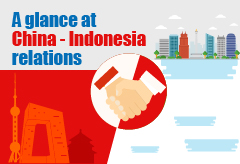China’s cooperation with Indonesia spells benefits for ASEAN as well
2018-05-06
Xinhua
BEIJING — Ahead of Premier Li Keqiang’s official visit to Indonesia next week, experts said stable ties between the two major developing economies will also enhance China’s cooperation with the Association of Southeast Asian Nations (ASEAN).
In recent years, China and Indonesia have seen frequent high-level exchanges, enhancing political mutual trust. Premier Li’s visit would help maintain the momentum of development of the bilateral comprehensive strategic partnership, which was established five years ago.
Dovetailing development plans
The two sides’ political and security cooperation has progressed, as well as cultural and humanitarian cooperation, Xu Liping, a senior research fellow with the National Institute of International Strategy at the Chinese Academy of Social Sciences, said.
Their diversified economic interactions include infrastructure projects like the Jatigede Dam in Indonesia and scheduled construction of cooperative industrial zones.
From the annual session of its top legislative body in March to the Boao Forum for Asia conference in April, China has used every important podium to reiterate its commitment to opening up further as well as supporting economic globalization.
The opening-up has benefited Indonesia, which is a participator of the China-proposed Belt and Road Initiative (BRI).
Xu said the Premier’s visit is expected to advance pragmatic cooperation through the dovetailing of BRI and Indonesia’s development strategies, including the Global Maritime Fulcrum.
Deepening China-ASEAN ties
As the largest economy in ASEAN, Indonesia’s stable relations with China would bring additional benefits to entire Southeast Asia.
Premier Li plans to visit the ASEAN Secretariat in Jakarta. It has been 15 years since China and ASEAN established their strategic partnership. China has been the largest trading partner of ASEAN for nine consecutive years, with bilateral trade totaling a record high of $514.8 billion last year.
“China-ASEAN cooperation is the most successful and dynamic in the Asia-Pacific region,” Foreign Minister Wang Yi said in March.
China-ASEAN ties have been strengthened through subregional mechanisms, such as the Lancang-Mekong Cooperation (LMC) mechanism between China and the five Mekong River nations of Cambodia, Laos, Myanmar, Thailand and Vietnam.
ASEAN could be a perfect platform for China to deepen subregional cooperation, as it has its own comprehensive development plan, the Master Plan on ASEAN Connectivity 2025, and thus provides a coordinative foundation for third parties, Song Junying, deputy director of the Department for Asia-Pacific Security and Cooperation Studies at the China Institute of International Studies, said.
The East ASEAN Growth Area (BIMP-EAGA) framework could also join the LMC for collective development efforts from the sea, Song added.
The BIMP-EAGA was launched in 1994 by Brunei, Indonesia, Malaysia and the Philippines, to accelerate and balance their economic development.
Upholding free trade
Asian countries have always embraced globalization and free trade through bilateral and multilateral channels.
While China and ASEAN are working on an “upgraded version” of the ASEAN-China Free Trade Area and building the Free Trade Area of the Asia-Pacific, BRI is consolidating the economic integration of Asia through investment and a transportation network.
China hopes ASEAN would keep promoting free trade in Asia, Song said.
Besides working on political and security issues, the two should also come up with new economic practices for win-win results, he added.


